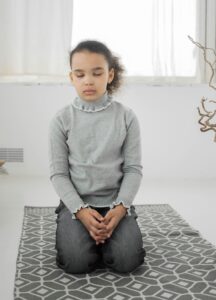Creating a calm and focused classroom environment is essential for student success. Whether students are dealing with frustration, anxiety, or overstimulation, having structured calming activities for the classroom can help them regulate their emotions, refocus, and feel more at ease.
By incorporating mindfulness techniques, sensory strategies, and self-calming exercises, teachers can provide students with valuable tools to manage stress and stay engaged in learning. In this article, we’ll explore effective calming classroom ideas, relaxing activities for students, and structured mindfulness exercises that can easily be implemented in any classroom setting.
The Importance of Calming Strategies in the Classroom
Students experience a variety of emotions throughout the school day. Some may struggle with anxiety, others may feel anger or frustration, and many simply need moments to pause and reset. Providing calming strategies for teachers and students fosters an emotionally safe learning space while equipping children with lifelong self-regulation skills.
Benefits of Calming Activities for Kids
- Reduces Classroom Stress: Simple classroom stress relief activities help students feel more at ease, leading to better focus and engagement.
- Promotes Emotional Regulation: Teaching self-calming strategies for students helps them manage strong emotions and respond thoughtfully rather than react impulsively.
- Encourages Mindfulness and Focus: Implementing a structured lesson plan on mindfulness helps students practice staying present and aware of their emotions.
- Supports Sensory Needs: Many students benefit from calming sensory activities for the classroom, which help reduce overstimulation and improve concentration.
By incorporating intentional calming strategies for anxiety and anger, teachers can transform their classrooms into peaceful and supportive environments.
Mindfulness-Based Calming Activities for the Classroom
Mindfulness is a powerful tool for helping students slow down, center themselves, and build awareness of their thoughts and emotions. Below are calming activities for students that teachers can implement daily.
1. The Empty Balloon Exercise
One of the most effective calming strategies for anger and anxiety is mindful breathing. The Empty Balloon Exercise teaches students how to release tension and regulate their breathing to achieve a sense of calm.
How It Works:
- Ask students to imagine they are holding a balloon in their hands.
- Instruct them to take a deep breath in through their nose and slowly exhale through their mouth, as if they are filling the balloon with air.
- Repeat three to five times, encouraging students to focus on their breath and feel their body relax.
This simple yet powerful exercise helps students regain control of their emotions, making it a great calming activity for anger and anxiety.
2. Guided Mindfulness Meditation
 A structured lesson plan on mindfulness can include short guided meditation sessions to encourage self-awareness and emotional balance.
A structured lesson plan on mindfulness can include short guided meditation sessions to encourage self-awareness and emotional balance.
How to Implement:
- Start the morning with a two-minute mindful breathing session to set a calm tone for the day.
- Use a visualization exercise where students imagine a peaceful place and describe what they see, hear, and feel.
- Have students place their hands on their stomachs and focus on their breathing, noticing how their body moves with each inhale and exhale.
Regular practice of mindfulness strengthens students’ ability to manage stress and improves their ability to focus.
Calming Sensory Strategies for the Classroom
Many students benefit from sensory breaks in the classroom, which help them regulate their energy levels and refocus. Sensory-based calming activities for kids can be especially useful for students with sensory processing needs or those who experience anxiety.
Calming Sensory Activities for the Classroom
- Tactile Stress Balls: Squeezing a soft stress ball provides physical feedback that helps with emotional regulation.
- Weighted Lap Pads or Stuffed Animals: These provide a grounding sensation that can help students feel safe and secure.
- Calm-Down Jars: A jar filled with water and glitter can serve as a visual relaxation tool for students. Shaking the jar and watching the glitter settle can help them self-regulate.
Incorporating calming sensory strategies into daily routines ensures that students have access to tools that help them feel more at ease.
Movement-Based Calming Strategies for Students
Physical movement can also be an effective way to regulate emotions and promote relaxation. Encouraging students to engage in calming strategies helps maintain a balanced classroom atmosphere.
1. Stretching Breaks
- Seated Forward Fold: Have students sit with their legs extended and gently fold forward to stretch their backs and calm their nervous system.
- Butterfly Breaths: Sitting cross-legged, students gently flap their knees like butterfly wings while taking deep breaths.
- Star Pose: Students stand with their arms and legs stretched wide like a star, take a deep breath, and then bring their hands to their hearts.
A short sensory break in the classroom with stretching can significantly improve focus and relaxation.
2. Walk and Reflect
- Allow students to take quiet reflection walks around the classroom or hallway to reset their focus.
- Encourage them to walk slowly, notice their surroundings, and take deep breaths as they move.
- Pair this with reflective questions such as, “What are you feeling right now?” or “What’s something positive that happened today?”
These movement-based activities help students regulate their energy and encourages them to practice these self-calming strategies for students in a mindful way.
Using Tools of the Heart for Emotional Regulation
For a more structured approach to calming classroom ideas, Soul Shoppe’s Tools of the Heart Online Course provides teachers with step-by-step guidance for integrating mindfulness and emotional regulation techniques into the classroom.
This program includes:
✔ Interactive lessons on mindfulness and emotional intelligence
✔ Guided exercises for self-calming strategies
✔ Techniques for improving classroom communication and conflict resolution
By incorporating these strategies into daily teaching, educators can provide students with the skills they need to handle stress, frustration, and overwhelm effectively.
Creating a Calm and Supportive Classroom Environment
Establishing calming classroom ideas isn’t just about individual exercises—it’s about fostering an overall sense of peace and emotional well-being. Here are additional ways teachers can promote classroom stress-relief activities:
- Set the Tone with a Peaceful Classroom Design – Use soft lighting, neutral colors, and minimal distractions to create a calm atmosphere.
- Encourage Open Conversations About Emotions – Normalize discussions about feelings and self-care to build emotional intelligence.
- Implement Daily Mindfulness Practices – Incorporate a short breathing exercise, gratitude reflection, or movement break into each school day.
- Offer a Designated Calm-Down Space – Set up a quiet area where students can go to practice self-calming strategies for students when they need a break.
By prioritizing mindfulness and emotional regulation, educators can help students develop lifelong skills for managing stress and fostering well-being.
Bring More Calm to Your Classroom Today
Providing students with effective calming activities for the classroom is essential for creating a focused and emotionally balanced learning environment. By integrating mindfulness techniques, movement-based relaxation, and calming sensory strategies, educators can give students the tools they need to succeed.
Explore the Empty Balloon Exercise and Tools of the Heart curriculum today to bring more calm, mindfulness, and emotional resilience into your classroom!
You May Also Like:


